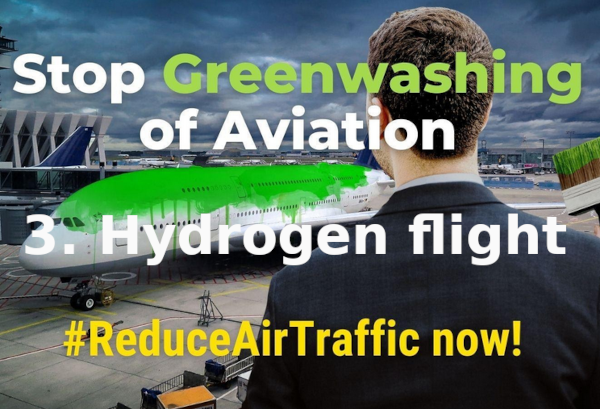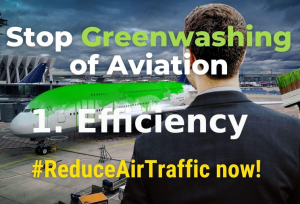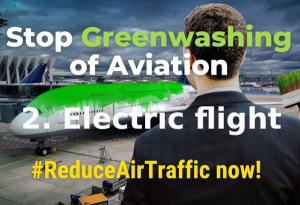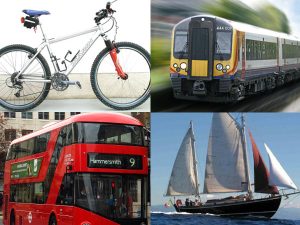Over five weeks we’re publishing a range of Stay Grounded factsheets about various kinds of techno-greenwashing provided by the aviation industry. Here we look at the promise of hydrogen-powered flight.
Here’s the series:
- Efficiency improvements
- Electric flight
- Hydrogen-powered flight
- Biofuels
- Synthetic electro-fuels (e-fuels)
There are plans to use hydrogen as a power source for aircraft instead of kerosene. It could either be burned in a jet engine or used to feed a fuel cell to generate electricity to power a propeller. It is produced from other energy sources, has a significant energy loss during the process and is usually stored in liquid form at −253 °C.
| WHAT THE AVIATION INDUSTRY TELLS YOU | WHAT THEY DON’T TELL YOU |
| Happening soon New aircraft propelled by hydrogen could enter into service by 2035. | Too late If it happens, it will come much too late to tackle the climate emergency. |
| Zero emissions When burned or used in a fuel cell, hydrogen does not produce any CO2, only water. | Not for medium and long-haul flights Hydrogen will not be viable for medium and long-haul flights before 2050. Until then, only the regional and short-haul market should be targeted, a large part of which can be substituted by road or rail. |
| Government support required Public money is needed for funding for hydrogen aircraft development and to subsidise hydrogen production. | Not zero emissions Hydrogen-powered aircraft will not have zero emissions, even if hydrogen is produced from renewable electricity, because it will still emit NOx and generate contrail cirrus that have a higher climate impact than CO2 today. |
| Huge energy consumption The deployment of “green” hydrogen in aviation would require huge quantities of renewable electricity, which would deprive other sectors needing to decarbonise. | |
| Success not assured Hydrogen-powered aircraft exist only on paper. Before it becomes a reality, many problems must be solved, especially in the field of safety, and new technologies must be developed. | |
| Financial support from governments means taxpayers pay …most of whom never fly. |
Airbus studied hydrogen aircraft in the 2000s but shelved their plans in 2010 due to technical issues that are yet to be resolved. In 2020, they then announced their intention to restart development of new hydrogen aircraft that could enter into service in 2035. They are studying four concept aircraft and will select one by 2025. Other manufacturers are also developing small hydrogen aircraft that may be certified in the 2020s.
Hydrogen aircraft unable to meet climate targets in time and quantity
Even if the aggressive schedule announced by Airbus in 2020 is met, it will be too late for the climate. According to the United Nations Environment Program (UNEP), worldwide GHG emissions must be reduced by 55% by 2030 and 90% by 2050 in order to not exceed the globally agreed 1.5°C heating limit. The design of a whole range of aircraft and the conversion of the fleet to hydrogen would start too late and take too long to meet this goal. Aircraft have a typical lifetime of 25 years.
According to a report produced by the European Commission (EC) in collaboration with key industry partners, hydrogen would be best suited for regional and short- to medium-haul flights. For long-haul flights, which contribute about one third of aviation emissions, hydrogen would not economically compete with synthetic fuels before 20505. By then, for that segment, the industry plans to rely upon alternative jet fuels (which will be covered in the next two articles). More recently, Airbus stated that a medium-haul aircraft would not be available before 2050, so, before that time hydrogen could potentially displace less than 20% of CO2 emissions.

Hydrogen would still have significant non-CO2 impacts
The EC report takes into account the CO2 as well as the non-CO2 impact of aviation on climate, NOx, water vapour and contrails, considering that the total impact is 3.1 times that of CO2 alone. It estimates that the total climate impact could be reduced by only 50-75% versus kerosene if hydrogen is burned in turbines and 75-90% if it is used in fuel cells. But this is still highly hypothetical.
Producing green hydrogen would require huge renewable electricity resources
Hydrogen aircraft are part of a new economy of hydrogen aiming at replacing fossil fuels where electricity is not a possible alternative. In order to be “carbon-free”, hydrogen needs to be produced with renewable electricity (green hydrogen > see infobox).
The challenge is that the energy requirements are huge and will exceed production capacities needed to:
- Replace coal and gas in power plants that supply the electric grid
- Help satisfy new demand for electricity (cars, heating, data, etc.)
- Replace today’s grey hydrogen (produced from fossil fuels) used for industrial processes (e.g. fertiliser production)
- Satisfy new demand for hydrogen for trucks, ships…
- Satisfy new demand for hydrogen for production ofe-fuels for aviation
In a scenario where 40% of the airline fleet would be converted to liquid hydrogen in 2050 and the rest of the fleet would use e-fuels, the resulting electricity demand would be equal to the current total worldwide electricity production and about four times the production of renewable electricity in 2018. As demand for electricity grows so does the risk that renewable electricity supply will not be able to match it, which will increase the risk of using non-renewable power.
Financial support from governments is unjustified: the polluter should pay
However: given that most taxpayers rarely or never fly, it would be unfair for them to subsidise research and development, particularly as the commercial success of hydrogen is uncertain; timescales are lengthy; and any significant deployment of hydrogen aircraft would be a waste of limited renewable energy resources.
Grey, blue and green hydrogen
This colour code refers to different production methods:
- Grey Hydrogen = produced from methane or coal (both fossil fuels)
- Blue Hydrogen = Grey Hydrogen combined with Carbon Capture & Storage (CCS)
- Green Hydrogen = produced (via electrolysis) from water via renewable electricity
In 2018, the vast majority of the hydrogen production was “grey”, accounting for 2% of total global CO2 emissions. Only 0.5% of the production was “green”, and a tiny amount was “blue”. “Blue” hydrogen is unproven at scale, and ultimately still involves the use of fossil fuel and may produce more carbon emissions than simply using “grey” hydrogen.
Today, hydrogen is mostly used by industry, for oil refining and for producing ammonia fertilisers. But many sectors, including aviation, are exploring its potential to support clean energy transitions and a new hydrogen economy is being projected.
As new uses for hydrogen develop, there is a major concern that the oil and gas sector will continue with business as usual in order to fulfill new hydrogen demand by extracting it from fossil hydrocarbons, rather than leaving it in the ground.
Success is far from assured
Hydrogen flight is unproven, with many technical and safety aspects yet to be understood. There is some skepticism even within the aviation industry. Boeing is not following Airbus and engine manufacturers have expressed reservations. Even Airbus have admitted that hydrogen will not be widely used in planes before 2050, stating that only regional 50-100 seaters would be ready for hydrogen in the 2030s, a small market with a small share of current CO2 emissions. If airlines transition to using a large amount of such aircraft, this will substantially affect their operations and the design of airport infrastructure (e.g. runways, gates, terminals, fuelling and maintenance requirements). It would therefore be sensible to halt aviation expansion plans until we know to what extent hydrogen aircraft will be used.







